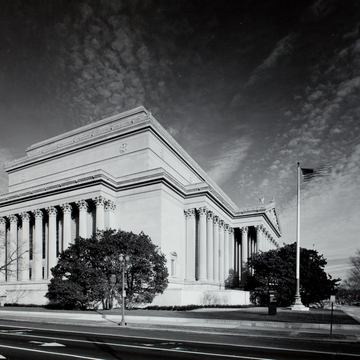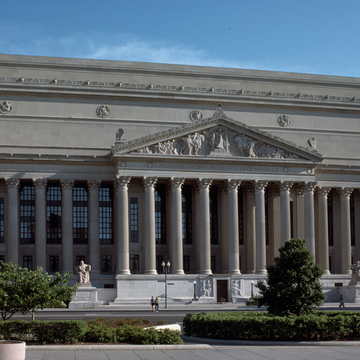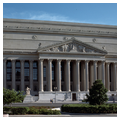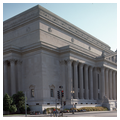Located between two busy north-south thoroughfares, the National Archives occupies a strategic location in the city's plan. Its central portico looks north along 8th Street, a street that Pierre L'Enfant assigned for special treatment because it lay midway between the Capitol and the White House. Robert Mills's Patent Office building secured the importance of the thoroughfare between F and G streets.
In the early twentieth century, the Carnegie Library reinforced the street's importance to the north on K Street. The National
Few doubted that John Russell Pope was the most appropriate designer for this pivotal building. His designs for the DAR Constitution Hall and the National City Christian Church (see FB05 and NE17) were welcome classical contributions to the city's central area. Pope had also designed the monumental Baltimore Museum of Art. His success with these commissions and the National Archives no doubt led to the Jefferson Memorial and the Mellon Gallery of Art, today the National Gallery of Art (see ML16). The rapid succession of grand projects inspired fierce protestations from critics who were swept up in the oncoming wave of modernism.
The National Archives building serves two major functions. The first is expressed in the Constitution Avenue elevation, where a monumental staircase leads into a half-domed room in which documents sacred to the American republic are on exhibit. Stored in secure cases, these documents include the Declaration of Independence, the Constitution, and the Bill of Rights. The other function is indicated on the Pennsylvania Avenue elevation, the entrance to the reading rooms and archival vaults stored within a windowless stack.
As if to underscore the importance of 8th Street, the National Archives is taller than the other Federal Triangle structures. Its solid rectangular form is clad on all four sides with a Corinthian colonnade. On the Constitution Avenue elevation, the pedimented Corinthian portico extends out the center, meeting the staircase at its top. On the Pennsylvania Avenue side, the pedimented portico surmounts the base of the building, which contains a modest visitors' entrance. With the exception of the Constitution Avenue elevation, which is nearly windowless, the columns surrounding the structure partially mask vertical strips of windows. Heroic figures flank the north and south entrances and are set on pedestals incised with mottos relating to the study of history.













